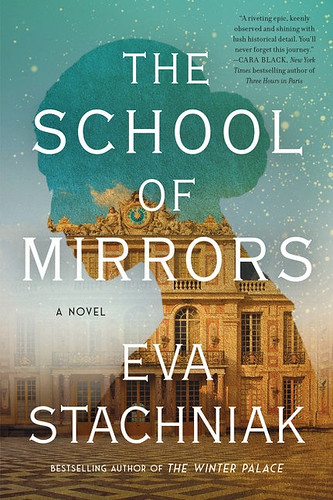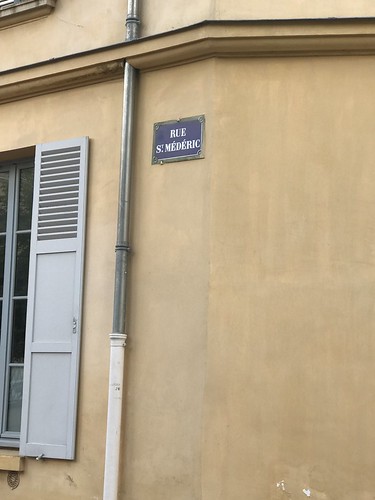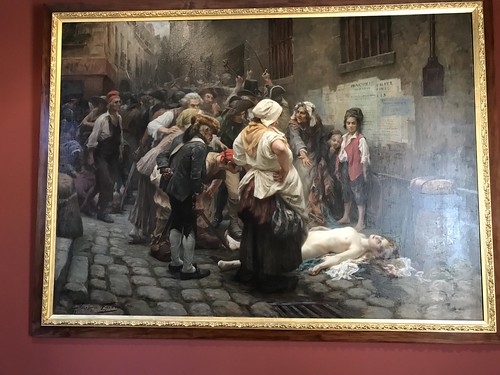Read This: Captivating History Comes Alive with The School of Mirrors
This is one of those magnificent books. You know...a book that you cannot put down, that time travels you back to a specific place and, while you’re reading it, you’re so engrossed that you look up and are surprised to be in the now?

Such is the case with The School of Mirrors, the latest historical novel from renowned author Eva Stachniak. We’ve shared how much we love her books here before (Empress of the Night and The Chosen Maiden), and how we completely live with the main characters while reading of their lives and stories.
One of Stachniak’s superpowers is the ability to take us so deeply into historical worlds that we will never view those people—and time periods—the same again.
In The School of Mirrors, readers are immersed in Versailles and Paris so completely that everything seems real: gorgeous fabrics, court happenings and power plays, social stratification, the harsh realities of childbirth, smoke, chaos, the French Revolution, life, death. We’re entranced with details both large and small, have become familiar with life then, and have absorbed so many aspects of these characters that they will forever remain in our minds and hearts.
From bringing a remote king to life to teaching about advances in the field of medicine to perusing the sky with a future king and learning how dreams and lives follow different paths, Stachniak has us hooked.
Highly, highly recommended.
Eva Stachniak is an award-winning and internationally bestselling author of six novels, including The Winter Palace, Empress of the Night, and The Chosen Maiden. She holds a PhD in literature from McGill University. Born and raised in Poland, she moved to Canada in 1981, and lives in Toronto.

We were lucky enough to talk with Stachniak about her new book, inspiration, research, and more. Here’s what she had to say...
Please tell us about your new book, The School of Mirrors...
The School of Mirrors is a story of mother and daughter in 18th century France. The mother, Veronique, is a Deer Park girl, one of the young lovers of Louis XV, groomed for him by his courtiers. The daughter, Marie-Louise, grows up among the Versailles servants and becomes a midwife in Paris.

What inspired you to write this book?
A passage from The Private Memoirs of Madame du Hausset, Lady’s Maid to Madame de Pompadour, in which Madame de Pompadour asks her maid to make arrangements for a “young lady’s confinement.” It soon becomes clear that the girl is pregnant with the king’s child and that she is unaware of her lover’s identity.
The passage led to my discovery of Deer Park, a secret house in the town of Versailles where Louis XV’s servants kept attractive lower-class girls to satisfy their master’s fancy. The house has always been shrouded in mystery, but I did find out that the girls were brought there ostensibly to be trained as ladies’ maids, told that their master and benefactor was a Polish count, a cousin of the queen, who kept an apartment at Versailles. Groomed to become the king’s lovers, they were sworn to secrecy and married off once they were no longer wanted. If they got pregnant, their children were taken away, raised in foster families, and never told who their true parents were.
I could not get this passage out of my mind, especially since the news was full of revelations of the #metoo movement, including the sordid details of Jefferey Epstein’s abuse of young women. This is when I began hearing the voice of Veronique Roux, a Deer Park girl, yet unaware of what fate had in store for her.

5 rue St Médéric, in the town of Versailles, the street where Deer Park once stood, no longer there
I love how deeply you research your novels. What were the joys and surprises of researching this time period?
This book got me to research the history of Versailles, both the palace and the town, with its tantalizing links to the French Revolution.

Everyday pottery commemorating the execution of Louis XVI, at the Museum of French Revolution in Vizille
The joy, as always, was following in the footsteps of my characters--the courtiers and Deer Park girls at the Palace of Versailles, the midwives of Paris during the French Revolution—and discovering the details of their lives. It made me reflect on how great historical events play out in the course of ordinary lives. How women manage to give birth, feed and raise children, while the world around them is turning upside down, when nothing can be taken for granted.

A painting of street life from during the prison massacres at the Museum of French Revolution in Vizille
My most surprising discoveries? In the 18th century, French–and especially Parisian--midwives were among the very best in the world. They were valued and well compensated for their work and expertise. Many of them worked tirelessly to improve the health of women and newborn babies. Madame du Coudray, who inspired me to create the characters of Aunt Margot and her adopted niece Marie-Louise, was one such midwife. Realizing that provincial French women lacked quality pre and post-natal care, she developed a training course for peasant women and toured France for over two decades spreading the knowledge and practice of midwifery.
And, to his credit, Louis XV, supported her!
Does researching and writing a novel take over your life? Touches you in ways you may not have anticipated?
Writing a novel demands so much energy and dedication that each new book becomes an obsession. During the four years when I worked on The School of Mirrors, I immersed myself fully in my characters’ lives. I read 18th century novels, pamphlets, police reports. I talked to historians, and midwives. I travelled to France in search of the sights and tastes of the past.

From the Palace of Versailles: A portrait of Queen Marie Leszczyńska, the wife of Louis XV, who has her scenes in the novel
The book took me not only to Versailles and Paris, but also to Rouen, to the Flaubert Museum of the History of Medicine, where I found myself in front of Madame du Coudray’s obstetrical mannequin, the famous Machine.

Madame Angélique du Coudray’s mannequin, The Machine, which she used in teaching peasant girls the art of midwifery. At the the Flaubert Museum of Medicine, Rouen
I found it very moving to stand in front of the Machine, which has been instrumental in empowering generations of young peasant girls. Completing Madame du Coudray’s training course turned them into licensed midwifes, respected and powerful members of their communities capable of saving the lives of countless mothers and babies. Looking at this faded and well-used educational tool, I imagined Madame du Coudray at Versailles, demonstrating her invention before Louis XV and Madame de Pompadour. The museum also imprinted on me the pain of illegitimate children and their mothers. One of the exhibits reconstructed the trap entrance of an orphanage, where a mother could place a swaddled baby, ring the bell, and “vanish.” Beside it, the museum curators placed thick ledgers opened on the pages registering these acts of desperation and hope: notes the mothers left with their babies, pieces of fabric, half of a playing card with hearts on it, a drawing of a bleeding heart…

The Flaubert Museum of Medicine, in Rouen
How can people find your work?
Most bookstores carry my books, so a trip to your favourite bookstore is a good start. My website www.evastachniak.com has links to my publishers and booksellers in Canada and the US.
You can also find me on social media:
Twitter handle: @EvaStachniak
Facebook page: https://www.facebook.com/EvaStachniak.Author
Instagram page: @estachniak
What's up next for you?
I am one of these writes who cannot find peace without a novel to plunge into.
This time I’m following in the footsteps of Giuseppe Balsamo, better known as Count Cagliostro, a Sicilian occultist or merely a charlatan who knows how to manipulate those around him. The woman I am trying to understand is his wife, Seraphina, his disciple and his victim.
Is there anything else you'd like to share with us?
Even though the writing of The School of Mirrors was completed in 2018, I did my final editing in the first months of the pandemic when I felt locked, isolated, and scared.
At this trying time, I re-read and fine-tuned my novel with a deep sense of how much more I share with my characters than I anticipated when life seemed orderly and calm. I thought of Veronique locked at Deer Park in an illusory world of opulence, unaware of the great price she would have to pay for her splendid isolation in the future. I thought of Marie-Louise, who lived through the French Revolution, through its angry, charged, deeply divided politicized days, weeks, and months. The time of accusations and frenzied rhetoric oblivious to nuance. I reflected on the unpredictability and precariousness of our fragile lives. On how everything we take for granted can be upended and threatened in an instant.
All these thoughts made the final edits much more poignant, resonant, enriched by what was happening around me.

A prisoner's cell from the time of the French Revolution--Conciergerie, in Paris
All photos courtesy and copyright Eva Stachniak
-

- Log in to post comments


















